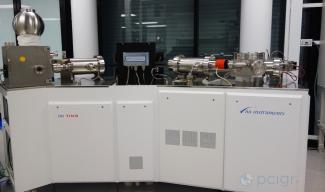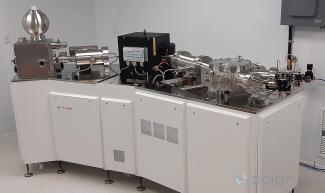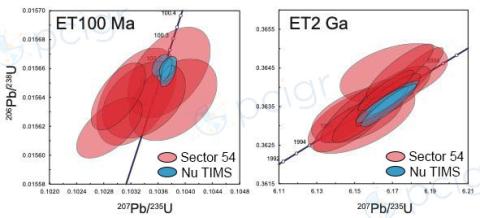PCIGR’s TIMS instruments are set up for high-precision measurements of radiogenic isotopic ratios (Sr, Nd) or U-Pb geochronology, in rock, mineral and ore samples.
|
Make/model |
Configuration |
Services |
|
Nu Instruments Nu TIMS (NT002) |
Multicollector |
|
|
Nu Instruments Nu TIMS (NT015) |
Multicollector |
|
|
Micromass VG354S |
Single collector |
U-Pb Geochronology |
|
Micromass VG54R |
Single collector |
U-Pb Geochronology |
Nu TIMS (Isotopic analyses)

Nu Instruments Nu TIMS for radiogenic isotope analysis in the nUBC facility at PCIGR. Photo: D. Weis.
The Nu TIMS is used to measure Sr and Nd isotopic ratios, with reproduceable analyses achieved on small sample loads down to <10 ng for Sr and <20 ng for Nd.
Installed at PCIGR in 2014, this Nu TIMS (serial number NT002) is equipped with the following features:
- Advanced filament assembly
- Patented zoom lens system for perfect peak alignment without needing to move the detectors
- Variable dispersion multicollector technology for improved versatility and performance
- Ion-counting mini-Daly and an ion counter capable of precise measurements of small samples and low-abundance isotopes
This Nu TIMS unit was the first TIMS commercially produced by Nu Instruments. This TIMS was designed as part of a collaborative research and development partnership between PCIGR and Nu Instruments, with the aim to improve analytical techniques and instrument design that benefits the research community. Visit our Research and Development page for more information.
PCIGR actively monitors the performance of this Nu TIMS through the analysis of standards (e.g., SRM 981, JMC-475, La Jolla or JNdi) and reference materials (USGS and others). To see a gallery of our historical instrument performance, click on the thumbnail image below.

PCIGR-radio-iso-analysis-SRM [PDF]
Contact Dr. Dominique Weis for details on instrumentation and Dave Daquioag submitting samples.
Consult the Fees page for analytical costs.
Nu TIMS (Geochronology)

Nu Instruments Nu TIMS for U-Pb geochronology at PCIGR. Photo: A. Chang.
Installed at PCIGR in 2022, this Nu TIMS (serial number NT015) is used exclusively for high-precision U-Pb geochronology and is equipped with the following features:
- Collector block with 16 Faraday cups, arranged for static Faraday U analysis and Faraday-Daly dynamic Pb runs for large sample sizes
- Ion-counting Daly detector that allows stability, linearity and dynamic range for precise measurement of small samples and low-abundance isotopes (e.g., 204Pb in zircon)
- Electronically switchable amplifiers: x 1011-ohm resistors for large ion beams, x 1012-ohm resistors for enhanced signal-to-noise ratios on small ion beams
- Electronically switchable pre-amp bin for greatest flexibility in analyzing a wide dynamic range of sample sizes with minimal downtime (<1 hr)
At PCIGR, this Nu TIMS supersedes our Micromass VG54R and VG354S TIMS and is used exclusively for the following applications:
- Single-grain zircon chemical abrasion (CA-TIMS) U-Pb
- Variety of U-Pb accessory phases (e.g., baddeleyite, titanite, rutile, apatite)
- U-Pb isotope-dilution TIMS geochronology

Improved precision and accuracy of dating from the Nu TIMS, as compared to the VG54R (Sector 54). Compiled by C. Wall.
Contact Dr. Corey Wall for details on instrumentation and submitting samples.
Consult the Fees page for analytical costs.
Micromass VG54R and VG354S TIMS

Micromass VG54R and VG354S TIMS at PCIGR. Photo: D. Weis.
The VG54R single-collector TIMS was purchased by the Department of Geology at UBC in 1982. The instrument underwent major upgrades in 1987 and 1995.
The VG54R is equipped with the following features:
- Automated 16-sample turret
- Faraday collector
- Daly photomultiplier for low-level Pb analyses (<1 ng radiogenic Pb)
- Digital voltmeter
At PCIGR the VG54R is primarily used for the following applications:
- Determination of Pb and U blanks from ultra-pure reagents produced in-house
- Determination of blanks from common Pb and U-Pb studies
- Single-grain zircon chemical abrasion (CA-TIMS) U-Pb
- U-Pb accessory phase analysis
- Common Pb analysis of sulphide minerals and feldspar
The VG354S single-collector TIMS was acquired by PCIGR from the University of California at Berkeley and installed in 2008.
The VG354S is equipped with the following features:
- Sector 54 electronics
- Latest version of Sector 54 software
- Automated 20-sample turret
- Oversized Faraday collector (originally acquired to facilitate Ca isotopic analyses)
- Analogue Daly collector for low-level U-Pb analyses
- Digital voltmeter
- Digital pyrometer
Since 2009, the VG354S TIMS has been used exclusively for the following applications:
- Single-grain CA-TIMS U-Pb analysis of zircon
- Variety of U-Pb accessory phases